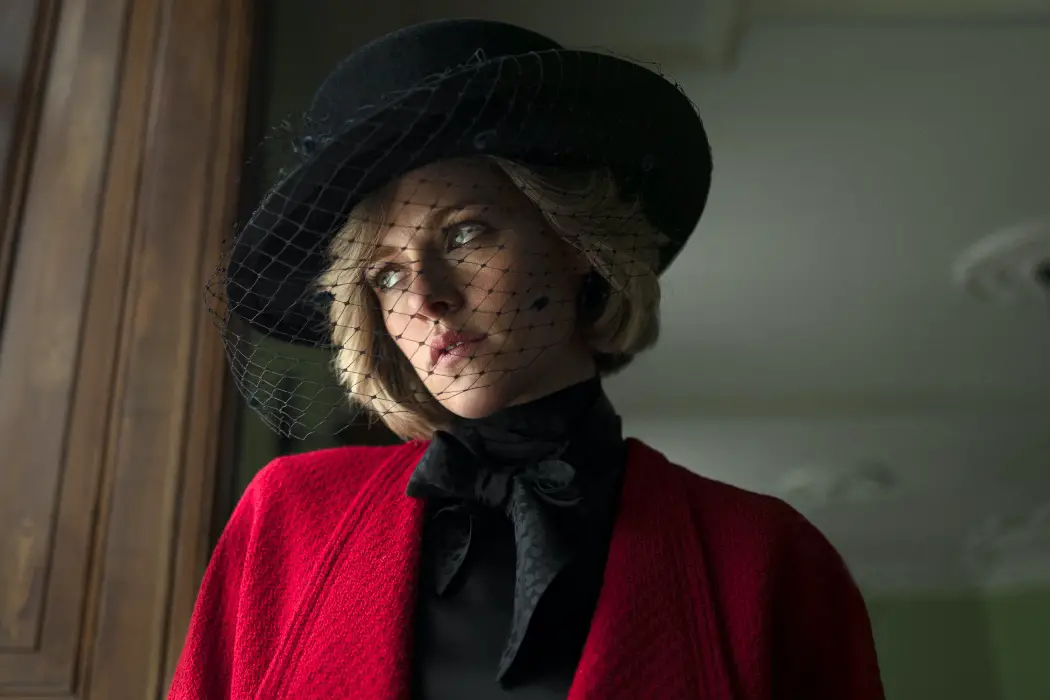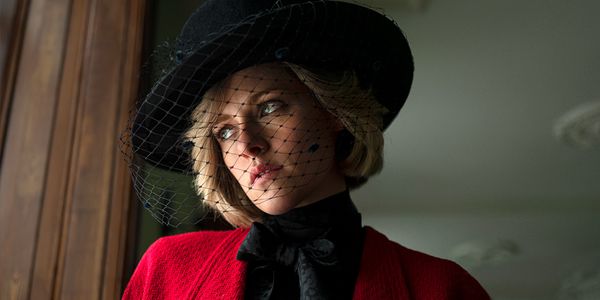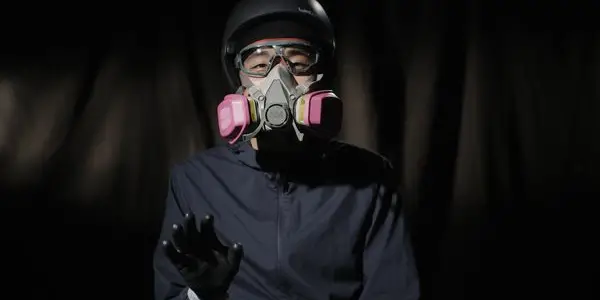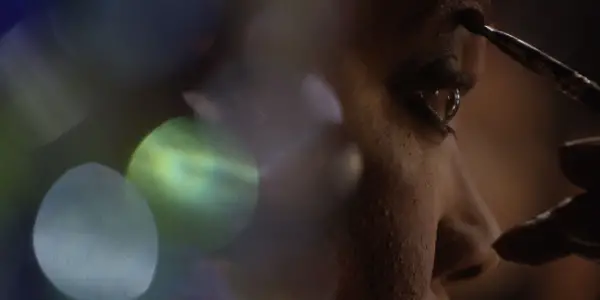HIFF Report 1: SPENCER, NINJABABY, FACELESS, & BEING BEBE

Alex is a film addict, TV aficionado, and book lover.…
The Heartland International Film Festival celebrates its 30th anniversary this year with a lineup that shows off its growth into a festival that brings the work of premiere international filmmakers, local talent, and everything in between to the crossroads of America. For my first report, I pop around the globe for movies about a struggling royal, an unexpectant mother, desperate protestors, and one of the greatest drag performers.
SPENCER (Pablo Larraín)

Biopics get a bad rap, but there’s a great opportunity in taking on the life of a real person. Many filmmakers recognize this and wield their art form as the powerful piece of propaganda it is, using it to reframe history, resurrect forgotten heroes, or, perhaps, give people the kindness they never received in life.
Director Pablo Larraín is hardly new to spinning wild tales about figures from the past, having already taken on Jacqueline Kennedy and Pablo Neruda in films that proved he’s less concerned with pedantic history lessons than in dealing with history as it really is: the stories we tell.
Now he turns that loosey-goosey approach to Diana, Princess of Wales, born Diana Spencer, a figure that hardly needs additional interpretations. More famous than one could fathom and alive during most adults’ lifetimes, nearly everyone has an idea of her and hardly anyone knows the truth, obscured as we are by her own formidable wielding of her persona. What, then, is there to add to a figure that’s already been a fairy tale, a tragedy, and everything in between?
Turns out, not a whole lot. Larraín once again applies a moody, impressionistic veil over a boiling point in his subject’s life, this time a Christmas gathering right as Diana and Prince Charles are about to split up. Holidays are stressful for lots of people, but the British royal family ups the ante by layering on ridiculously arcane traditions, essentially suffocating Diana. The film is frank about how this exacerbates her eating disorder but inventive about her mental state as a whole, spinning events into a claustrophobic horror show with very real and very imagined terrors around every corner.
The problem is that this isn’t a revealing approach to Diana, or a novel one. A large section of pop culture sided with Diana after her divorce, and the massively popular television series The Crown has been exploring the suffocating nature of royalty and how it strips away humanity for the past several years. Spencer has little to say outside these ideas, but it says them with such gusto that it gives Kristen Stewart a new way to shine.
People who pay attention to the film have long taken Stewart seriously as an actor, so while you can’t describe her turn as Diana a revelation, it does add an intriguing skill to her set. Before this, I would’ve claimed that characters needed to form around the sheepish mannerisms that always came out of her. In other words, she always retained a bit of herself, never achieving the kind of full-bodied, physical movement transformation that allows the greatest actors to become any and every kind of character you can imagine (our current best at this, in my book, is Marion Cotillard).
With Spencer, Stewart shows that she may, in fact, have this ability within her. She never disappears into the role as one says; you always recognize that it’s Stewart playing Diana, but I’m not sure this movie either wants or needs that. Larraín is playing with the mythologizing of a real person, and much like Stewart’s turn in Clouds of Sils Maria, the fact that there are parallels between her character and her real-life adds to the commentary. But Larraín’s imaginative take does ask Stewart to commit fully to someone experiencing a full breakdown, which she does with a stiff-bodied version of her usual sheepishness.
Where the startling change comes is when Larraín veers towards something interesting, extending an imagined kindness that finally makes Spencer feel like the fable it claims to be. Here, Stewart’s movement changes as she releases her locked-up joints and spins madly, wildly, towards joy. The swell of emotion that comes from the character going through such a palpable change is the kind of acting that moves one into the upper echelon of performers, one that Stewart has been hovering around for years and may have finally broken through. And if that’s the only new thing Spencer brings to the table, well, that’s a hell of a discovery.
NINJABABY (Yngvild Sve Flikke)

Your first look at the tousled, frivolous protagonist Rakel doesn’t prepare you for the journey Ninjababy takes you on, and that’s a good thing. The depth and sweetness sneak up on you, well, like a ninja, transforming the instantly funny slacker comedy into the kind of movie you treasure and champion.
You know from the start that co-writer and director Yngvild Sve Flikke has keyed in on the charming, everyday bawdiness she wants the movie to emanate, following Rakel and her friend to a self-defense class where they chuckle through the realization that Rakel has slept with the instructor and dodge the inevitable dude who wants to break out the staffs and pretend he’s Donatello from Teenage Mutant Ninja Turtles. It’s silly, it’s casual, and it’s not at all hung up on idealizing the young women it centers. So it’s not surprising when Rakel stumbles into discovering she’s pregnant, greatly underestimates how far along she is, and realizes that abortion is no longer an option.
Faced with real adult responsibilities, she fumbles around like we all do, which allows actor Kristine Kujath Thorp to flop between playing her as endearing and frustrating. A lesser performer would get this balance wrong, tipping Rakel into a character you take sides on, but Thorp simply lets her be, displaying a naturalism that allows Rakel’s quirks and faults to simply exist on screen. The most bizarre of these quirks, and in its way the most painfully human, is when she begins imagining the little person growing inside her as one of her drawings come to life (the titular Ninjababy), which allows her to address her worst fears from a comfortable distance.
Yes, there’s a lot of Juno in this, not so much in the cutesy dialogue (this has a more arch sense of humor) but in the way it lets its main character have complicated feelings towards her pregnancy in an environment that doesn’t judge her no matter what choices she makes. It’s a grace so rare you barely realize how sorely missing it is until something like Ninjababy comes along, its nonchalant decency opening up all sorts of fresh avenues within the well-worn plot.
The fringes of the story prove equally as strong. The aforementioned self-defense instructor Mos worms his way into Rakel’s life by being, simply put, a good man, a subplot that puts a warm heart in a story populated by screwups. How many screwups, you ask? Well, Rakel isn’t even the worst offender. That honor goes to the soon-to-be father, nicknamed Dick Jesus, which tells you everything you need to know about him until the movie lets him grow, too, in yet another moment of unexpected decency. And, being a Norwegian film, it’s impossible not to relish the cozy attire, which does a lot of heavy lifting in telling you who’s got it together enough to put on an outfit versus who just throws stuff on to avoid freezing.
The movie really belongs to Flikke, though, who guides it through tricky emotional territory while keeping it light on its feet. She’s made a deeply humane film, one that really likes people for all our screwups.
FACELESS (Jennifer Ngo)

The odds were stacked against director Jennifer Ngo pulling off the documentary Faceless, which makes for a fitting parallel to her beleaguered subjects. They were the youth who took to the streets of Hong Kong in 2019 to protest the accelerated fall of their home to China’s strict regime. She was the filmmaker trying to capture the sprawling, chaotic movement that, we now know, was doomed to fail. Easy tasks all around.
The name of the documentary comes from the fact that none of the protesters can show their faces, for identification would be the same as capture, and capture would bring such dire consequences that the documentary seems hesitant to name them outright. “Taken to the mainland,” as one of the protesters calls it, is both an accurate and undersold description of what happens when you oppose the Chinese government per the whispers that have gotten out, making it both a truth and a euphemism.
Anyone who saw media coverage of the protests will know the kind of violent footage they’re about to see. Tear gas fills the air, blood flows, and Molotov c*cktails appear from ragtag style assembly lines. Ngo and her team went right to the front lines of clashes between protesters and police to capture the chaos, but the more intriguing moments come from the quiet interviews with her subjects, time that allows them to digest and disagree about what’s going on around them.
Ngo focuses on four protesters: the artist, the daughter, the student, and the believer (real names, for aforementioned reasons, can’t be given). Each pontificate on their reasons for joining the hopeless movement, and each eventually reach moments of despair. Most affecting is the daughter, so named because she’s the daughter of a police officer, whose telling of the generational and political divide ripping apart their home is the kind of heartbreaking personal cost that grounds the extraordinary footage in everyday life.
Unfortunately, Ngo doesn’t spend as much time on these moments as she should, instead getting caught up in the raw footage of the protests and in explanations of the political history of Hong Kong. The latter is a necessary evil, as most viewers will have sparse knowledge of just how much the people of Hong Kong are about to lose. The former, though, betrays the lack of filmmaking finesse Ngo brings to the table as a reporter turned documentarian. She gets across the situation clearly and makes you feel the dire straits these people are in, but she lacks the ability to turn the situation’s restrictions into strengths. This will feel particularly acute if you saw last year’s Welcome to Chechnya, which followed another group of necessarily anonymous subjects that turned their obscured faces into one of the most breathtaking moments of cinema in 2020.
Without such maneuvering, Faceless remains a bit too impersonal, hewing more towards a journalistic take on events than the personal document it aspires to be. Still, this is incredible footage of the last gasps of freedom before it’s swallowed whole, a struggle that proves well worth documenting.
BEING BEBE (Emily Branham)

Before drag went mainstream in America, RuPaul’s Drag Race premiered as one of the scrappy shows on the LGBTQ+ channel Logo TV. Scrappy is how you would describe all drag back then (and most still today), and it especially describes the consummate performer behind its inaugural winner, BeBe Zahara Benet.
Director Emily Branham takes you through the journey of what led to and came after that win in Being BeBe, a winding tale that doesn’t find a solid arc but survives on the electric moments its subject conjures from thin air.
Fans of the first season of Drag Race took to yelling “Cameroon” as she strutted back in 2009, a nod to performer Marshall Ngwa’s origins. He grew up in the homophobic country, moved to Minneapolis, Minnesota as a young man, and found a home with a supportive family friend and the nightclub Gay ’90s. Branham wastes no time drawing attention to the inescapability of dangerous prejudice no matter where Marshall ends up. She delves periodically into the legal status and day-to-day life of queer people in Cameroon and establishing shots of Minneapolis show a prominent George Floyd memorial. Being a Black drag performer puts all sorts of targets on him, but thankfully much of the documentary is about how Marshall squirms past them all.
Early footage of his career is the most riveting, with finely assembled clips of BeBe’s shows at Gay ’90s and Marshall’s laser focus on the art form getting across both the joy and the hard work that goes into producing it. “My week has been a living hell,” groans BeBe’s seamstress before taking a joyless bite of jerky. Instantly, I wanted to know everything about this person.
Moments like this make you lament that Branham never finds a balance between exploring the world around Marshall and mapping the trajectory of his wobbly shot at fame. His attempt to create a career post-Drag Race, something he rightly points out there was no blueprint for, could’ve been its own fascinating path of ups and downs, but that momentum is interrupted by asides from queer Cameroonians that seem intended to fill in familial and cultural tensions Marshall is hesitant to discuss directly. And yet others who come in and out of Marshall’s life, who could’ve filled in as many gaps and provided parallels as the people in Cameroon, are left by the wayside. What could the other Black drag performers he works with have told us about being a person of color in this world? What could his backup singers and dancers have said about the disappointment of a signature show collapsing under financial strain? Or how about the wealth of knowledge about the career’s grind almost certainly carried by the drag performer he leaves at Gay 90’s in the late 2000s and returns to, still in the same cramped backstage, nearly ten years later?
Marshall’s long career as BeBe is a fascinating one, and he’s an eager, enthusiastic guide through the ups. He’s more cagey about the downs, though, and while Branham doesn’t quite find a way around his rose-tinted glasses to make his darker moments hit, it’s fun enough just to take in the good times.
That’s the first of three reports from HIFF. Which film intrigued you the most? Let us know in the comments!
Does content like this matter to you?
Become a Member and support film journalism. Unlock access to all of Film Inquiry`s great articles. Join a community of like-minded readers who are passionate about cinema - get access to our private members Network, give back to independent filmmakers, and more.
Alex is a film addict, TV aficionado, and book lover. He's perfecting his cat dad energy.













